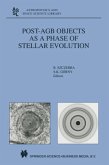Hydrogen Deficient Stars and Related Objects
Proceeding of the 87th Colloquium of the International Astronomical Union Held at Mysore, India, 10¿15 Nevember 1985
Herausgegeben:Hunger, K.; Schönberner, Detlef; Rao, N. K.
Hydrogen Deficient Stars and Related Objects
Proceeding of the 87th Colloquium of the International Astronomical Union Held at Mysore, India, 10¿15 Nevember 1985
Herausgegeben:Hunger, K.; Schönberner, Detlef; Rao, N. K.
- Broschiertes Buch
- Merkliste
- Auf die Merkliste
- Bewerten Bewerten
- Teilen
- Produkt teilen
- Produkterinnerung
- Produkterinnerung
The first helium star was discovered in 1942, the first scientific meeting on the subject, however, took place in 1985. The meeting was hence long overdue for, in the meantime, a substantial amount of material had been accumulated by a rather small, but active scientific community. Hence, it appeared necessary to review the field in order to define the subject, assess its present status and discuss future developments. Hydrogen deficiency is a widespread phenomenon, occurring in a large variety of stellar and nonstellar objects. It can be readily detected in B stars as these exhibit both…mehr
Andere Kunden interessierten sich auch für
![Hydrogen Deficient Stars and Related Objects Hydrogen Deficient Stars and Related Objects]() K. Hunger / Detlef Schnberner / N.K. Rao (eds.)Hydrogen Deficient Stars and Related Objects113,99 €
K. Hunger / Detlef Schnberner / N.K. Rao (eds.)Hydrogen Deficient Stars and Related Objects113,99 €![Cataclysmic Variables and Related Objects Cataclysmic Variables and Related Objects]() M. Livio / G. Shaviv (Hgg.)Cataclysmic Variables and Related Objects121,99 €
M. Livio / G. Shaviv (Hgg.)Cataclysmic Variables and Related Objects121,99 €![Cataclysmic Variables and Related Objects Cataclysmic Variables and Related Objects]() Cataclysmic Variables and Related Objects121,99 €
Cataclysmic Variables and Related Objects121,99 €![Post-AGB Objects as a Phase of Stellar Evolution Post-AGB Objects as a Phase of Stellar Evolution]() Post-AGB Objects as a Phase of Stellar Evolution116,99 €
Post-AGB Objects as a Phase of Stellar Evolution116,99 €![Post-AGB Objects as a Phase of Stellar Evolution Post-AGB Objects as a Phase of Stellar Evolution]() SzczerbaPost-AGB Objects as a Phase of Stellar Evolution122,99 €
SzczerbaPost-AGB Objects as a Phase of Stellar Evolution122,99 €![Activity in Red-Dwarf Stars Activity in Red-Dwarf Stars]() Activity in Red-Dwarf Stars42,99 €
Activity in Red-Dwarf Stars42,99 €![Mass Loss from Red Giants Mass Loss from Red Giants]() Mass Loss from Red Giants161,99 €
Mass Loss from Red Giants161,99 €-
-
-
The first helium star was discovered in 1942, the first scientific meeting on the subject, however, took place in 1985. The meeting was hence long overdue for, in the meantime, a substantial amount of material had been accumulated by a rather small, but active scientific community. Hence, it appeared necessary to review the field in order to define the subject, assess its present status and discuss future developments. Hydrogen deficiency is a widespread phenomenon, occurring in a large variety of stellar and nonstellar objects. It can be readily detected in B stars as these exhibit both hydrogen and helium lines, if the elements are present in appreciable amounts. It becomes less manifest in cool stars, where the temperature is too low to excite helium and where one has to devise indirect methods for proving hydrogen deficiency. Clearly, it was not possible to discuss the whole complex of hydrogen deficiency, i.e. in both stars and diffuse matter, but rather to concentrate on the issue of helium stars.
Hinweis: Dieser Artikel kann nur an eine deutsche Lieferadresse ausgeliefert werden.
Hinweis: Dieser Artikel kann nur an eine deutsche Lieferadresse ausgeliefert werden.
Produktdetails
- Produktdetails
- Astrophysics and Space Science Library 128
- Verlag: Springer / Springer Netherlands
- Artikelnr. des Verlages: 978-94-010-8608-0
- Softcover reprint of the original 1st ed. 1986
- Seitenzahl: 532
- Erscheinungstermin: 13. Oktober 2011
- Englisch
- Abmessung: 235mm x 155mm x 29mm
- Gewicht: 797g
- ISBN-13: 9789401086080
- ISBN-10: 9401086087
- Artikelnr.: 39505681
- Herstellerkennzeichnung
- Books on Demand GmbH
- In de Tarpen 42
- 22848 Norderstedt
- info@bod.de
- 040 53433511
- Astrophysics and Space Science Library 128
- Verlag: Springer / Springer Netherlands
- Artikelnr. des Verlages: 978-94-010-8608-0
- Softcover reprint of the original 1st ed. 1986
- Seitenzahl: 532
- Erscheinungstermin: 13. Oktober 2011
- Englisch
- Abmessung: 235mm x 155mm x 29mm
- Gewicht: 797g
- ISBN-13: 9789401086080
- ISBN-10: 9401086087
- Artikelnr.: 39505681
- Herstellerkennzeichnung
- Books on Demand GmbH
- In de Tarpen 42
- 22848 Norderstedt
- info@bod.de
- 040 53433511
I. Introduction.- Introductory comments.- II. Basic Data.- Basic data on hydrogen-deficient stars (Review).- Radial velocities of extreme helium stars and of hot sdO stars.- III Hot Extreme Helium Stars.- Spectroscopic analyses of hot extreme helium stars (Review).- Photometric properties of the extreme helium stars (Review).- High resolution spectroscopy of six new extreme helium stars.- Emission lines in high resolution spectra of extreme helium stars.- The peculiar spectrum of the extreme helium star BD-9°4395.- Non-radial pulsations in the extreme helium star HD 160641.- The period of the extreme helium star BD +1°4381.- A preliminary analysis of the pulsating extreme helium star V 652 Her (BD +13°3224).- The radial velocity curve of V 652 Her (BD +13°3224).- The light curve of the pulsating extreme helium star BD +13°3224: further evidence of a decline in the period decrease rate.- IV Cool Hydrogen Deficient Stars.- The chemical composition of cool stars: II-the hydrogen deficient stars (Review).- The RCB stars and their circumstellar material (Review).- Polarimetric observations of hydrogen deficient stars.- Distribution of light minima of R Coronae Borealis type stars.- Abundance analysis of R CrB variable UW Cen.- Spectrophotometric observations of R CrB during 1972, 74 minima.- Photometric and radial velocity variations of R CrB near maximum light.- Preliminary analysis of the broad He I emission lines in R CrB.- 3.0 to 3.5 micron spectrum of V 348 Sgr and R CrB.- RY Sgr: Can the time of the next deep minimum be predicted?.- RY Sgr: Pulsation related phenomenon.- Anomalous UV-extinction and the effective temperature of V 348 Sgr.- On the mass and luminosity of V 348 Sgr.- The Large Magellanic Cloud R CrB star - HV 12842.- V Hydrogen Deficient Binaries.-Hydrogen-poor binary stars (Review).- Photometric and spectroscopic variability of the hydrogen-deficient binary CPD -58°2721.- Hydrogen deficiency in Algol secondaries.- VI Intermediate Helium Stars.- Intermediate helium stars: Atmospheric parameters, oblique rotators and shells (Review).- Magnetic fields and winds of the intermediate helium stars (Review).- Helium-rich stellar atmosphere models for B stars.- Analysis of the helium strong star HD 37017.- SB 939 - a new intermediate helium star at high galactic latitudes.- Spectral variations of the rapidly oscillating Ap star HD 60435.- VII Related Objects.- Helium rich subdwarf 0 stars and central stars of planetary nebulae (Review).- UV- and visual spectroscopy of nine extremely helium rich subluminous O-stars.- NLTE-analysis of three extremely helium-rich O-type subdwarfs.- Hydrogen deficient planetary nebulae: preliminary results.- The origin and evolution of helium-rich white dwarfs (Review).- Temperatures for hot and pulsating helium-rich (DB) white dwarfs obtained with the IUE observatory.- Line band profiles in the spectra of cool magnetic helium-rich white dwarfs.- Detection of an extremely active state of AM Canum Venaticorum.- VIII Iras - Results.- IRAS results for hydrogen deficient stars (Review).- IX Theory.- Pulsations of hydrogen deficient stars (Review).- Theory of dust formation in R Coronae Borealis stars (Review).- Diffusion and He overabundances: hydrodynamical implications (Review).- Evolutionary status and origin of extremely hydrogen-deficient stars (Review).- On the origin of helium rich stars.- Summary.- X Appendix.- J.S. Drilling, P.W. Hill: Appendix A: A catalogue of hydrogen-deficient stars.
I. Introduction.- Introductory comments.- II. Basic Data.- Basic data on hydrogen-deficient stars (Review).- Radial velocities of extreme helium stars and of hot sdO stars.- III Hot Extreme Helium Stars.- Spectroscopic analyses of hot extreme helium stars (Review).- Photometric properties of the extreme helium stars (Review).- High resolution spectroscopy of six new extreme helium stars.- Emission lines in high resolution spectra of extreme helium stars.- The peculiar spectrum of the extreme helium star BD-9°4395.- Non-radial pulsations in the extreme helium star HD 160641.- The period of the extreme helium star BD +1°4381.- A preliminary analysis of the pulsating extreme helium star V 652 Her (BD +13°3224).- The radial velocity curve of V 652 Her (BD +13°3224).- The light curve of the pulsating extreme helium star BD +13°3224: further evidence of a decline in the period decrease rate.- IV Cool Hydrogen Deficient Stars.- The chemical composition of cool stars: II-the hydrogen deficient stars (Review).- The RCB stars and their circumstellar material (Review).- Polarimetric observations of hydrogen deficient stars.- Distribution of light minima of R Coronae Borealis type stars.- Abundance analysis of R CrB variable UW Cen.- Spectrophotometric observations of R CrB during 1972, 74 minima.- Photometric and radial velocity variations of R CrB near maximum light.- Preliminary analysis of the broad He I emission lines in R CrB.- 3.0 to 3.5 micron spectrum of V 348 Sgr and R CrB.- RY Sgr: Can the time of the next deep minimum be predicted?.- RY Sgr: Pulsation related phenomenon.- Anomalous UV-extinction and the effective temperature of V 348 Sgr.- On the mass and luminosity of V 348 Sgr.- The Large Magellanic Cloud R CrB star - HV 12842.- V Hydrogen Deficient Binaries.-Hydrogen-poor binary stars (Review).- Photometric and spectroscopic variability of the hydrogen-deficient binary CPD -58°2721.- Hydrogen deficiency in Algol secondaries.- VI Intermediate Helium Stars.- Intermediate helium stars: Atmospheric parameters, oblique rotators and shells (Review).- Magnetic fields and winds of the intermediate helium stars (Review).- Helium-rich stellar atmosphere models for B stars.- Analysis of the helium strong star HD 37017.- SB 939 - a new intermediate helium star at high galactic latitudes.- Spectral variations of the rapidly oscillating Ap star HD 60435.- VII Related Objects.- Helium rich subdwarf 0 stars and central stars of planetary nebulae (Review).- UV- and visual spectroscopy of nine extremely helium rich subluminous O-stars.- NLTE-analysis of three extremely helium-rich O-type subdwarfs.- Hydrogen deficient planetary nebulae: preliminary results.- The origin and evolution of helium-rich white dwarfs (Review).- Temperatures for hot and pulsating helium-rich (DB) white dwarfs obtained with the IUE observatory.- Line band profiles in the spectra of cool magnetic helium-rich white dwarfs.- Detection of an extremely active state of AM Canum Venaticorum.- VIII Iras - Results.- IRAS results for hydrogen deficient stars (Review).- IX Theory.- Pulsations of hydrogen deficient stars (Review).- Theory of dust formation in R Coronae Borealis stars (Review).- Diffusion and He overabundances: hydrodynamical implications (Review).- Evolutionary status and origin of extremely hydrogen-deficient stars (Review).- On the origin of helium rich stars.- Summary.- X Appendix.- J.S. Drilling, P.W. Hill: Appendix A: A catalogue of hydrogen-deficient stars.


